CLIMATE CHANGE: THE FUTURE EVOLUTION OF THE SEED SECTOR
Climate change is not a news anymore, but neither is out of topic. On the contrary, it has to be taken into account when developing a business model and it is important to consider the evolution that the seed sector could and will have based on this event. As a matter of fact, climate change is expected to have an impact on the agricultural sector, altering regional crop growing conditions and pest incidence. Even though the aggregate agricultural production is not expected to decline before 2050, some factors will change such as suitable zones, annual yields, and price volatility of agricultural commodities. This will of course have consequences on cultivation patterns, international trade and regional markets. It is known that the impacts of climate change in one region can have a butterfly effect on another through a range of mechanisms, including trade, infrastructure and finance.
Because of its dependance on soil characteristics, weather patterns and biodiversity, agriculture is one of the socio-economic sectors most sensitive to climate change. Climate change indeed affects precipitation, water flows, humidity and temperature. The frequency and magnitude of extreme weather and climate events will increase, and the distribution and abundance of pest species and pollinators may change. These changes will influence crop growth, phenology and yields, ultimately leading to shifts in zones suitable for cultivation and land use changes.
Climate change appears to have negatively affected productivity for major food crops in Europe and it is likely to be as it is until mid-century.
Since 1970, global food supply has largely kept pace with growing demand resulting from population growth and rising incomes. In the coming decade, this is likely to continue because of technological progress. In the long run, however, the impacts of climate change are projected to show up more and more, therefore affecting productivity, with prices expected to rise significantly. Furthermore, climate change can affect trade by derange transport and distribution chains.
In recent years, seed harvest yield remarkably dropped down, affecting food production, quality and prices.
The biggest change encountered by seed companies is that there is a lot more time involved due to unexpected and sometimes unpredictable extreme weather conditions. As a result, companies tend to rely on plants with a more resilient genetic makeup, so that they survive if not thrive.
Finally, more EU support for international adaptation to climate change is needed, particularly capacity building in producing countries, as announced in the blueprint for the new EU adaptation strategy. Sustainability paragraphs in EU trade agreements could drive necessary investments.
The seed sector keeps evolving according to the changes that the world shows, so what are some solutions and posssibilities to discover in the department of Research and Development? For example, the Grand View Research affirms that the global vertical farming market is expected to exponentially grow by 2030. As the expression suggests, vertical farming means farming on vertical surfaces rather than traditional agriculture. By doing so, farmers can produce more food using the same land or even less.
Sources:
https://www.eea.europa.eu/publications/global-climate-change-impacts-and
https://www.theguardian.com/environment/2023/oct/16/seed-farmers-climate-change
https://www.ceitec.eu/how-climate-change-affects-seed-development/t10991
https://www.developmentaid.org/news-stream/post/160056/vertical-farming-experts-opinions













